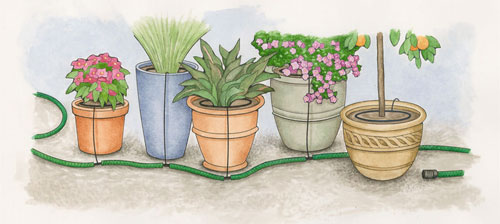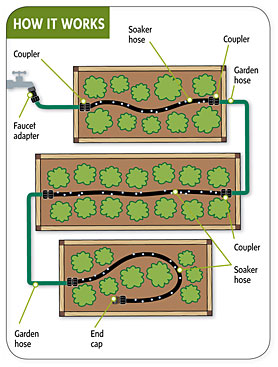





As a founding employee of Gardener's Supply, I wore many different hats over the years. Currently, I have my own company called Johnnie Brook Creative. The gardens around my home in Richmond, VT, include a large vegetable garden, seasonal greenhouse, cutting garden, perennial gardens, rock garden, shade garden, berry plantings, lots of container plants and a meadow garden. There's no place I'd rather be than in the garden.

With the Snip-n-Drip Pot and Planter Soaker System you can create a customized irrigation system that reduces watering chores and keeps plants hydrated and healthy.

No special tools are required for our Snip-n_Drip systems. Use scissors to cut the soaker hose to fit garden beds, and then cut the garden hose to cross areas that don't need water. Snap the fittings into place and you're ready to water. The weeping action of soaker hoses delivers water to the plants, with minimal loss due to evaporation and runoff. Learn more about Snip-n-Drip watering systems.
What are the two biggest users of water in your home? Toilets and landscape watering. In fact, during the summer, half of all household water use can be for the lawn and garden. However, it's possible to dramatically reduce your water consumption, lower your water bill and still have a beautiful, productive garden. Just follow these eight steps:
1. Add organic matter to your soil.
All soil is not created equal. Soil is essentially a collection of mineral particles of different sizes. If most of the particles are large (sand), water passes through rapidly. If most of the particles are small (clay), water will penetrate the soil much more slowly. The solution for either problem is the same: add organic matter. Organic matter, in the form of compost, chopped up leaves or composted manure will improve the texture and water-holding capacity of your soil. Add at least an inch of compost each year.
To learn more about improving your soil, read Building Healthy Soil.
Keep your garden well-watered with the right tools: soaker hoses, lightweight hoses, sprinklers, rain barrels and irrigation timers.
SHOP NOW
2. Deliver water to the root-zone.
Soaker hoses ensure that up to 90 percent of the water you apply to your garden is actually available to your plants. Sprinklers can claim only a 40 to 50 percent efficiency. Drip irrigation and soaker hoses minimize evaporation loss and keep the areas between plants dry, which also helps limit weed growth. Our Aqua Cones are an economical and effective way to get water directly to the roots of individual plants. The Flat Soaker Hose delivers water slowly and evenly in garden or landscape beds.
3. Use mulch to retain water.
A 6-8" layer of organic mulch can cut water needs in half by blocking thirsty weeds and reducing evaporation. Organic mulches retain some water themselves and increase the humidity level around plants.
Organic mulches include chopped or shredded leaves, straw, compost, salt hay, shredded newspaper, grass clippings and rotted hay. Inorganic mulches include Pro Weed Mat, Fiber Tree Rings and recycled rubber Tree Rings.
For more information about mulches, read Choosing the Right Mulch for Vegetable Gardens.
During photosynthesis, green plants use water and carbon dioxide to make their own food. They take up water through their roots and transport it through the plant to the leaves.
Carbon dioxide is taken up through microscopic pores in the leaves called stomata. When the stomata are letting in carbon dioxide, water vapor escapes through a process called transpiration.
Transpiration cools the plant (kind of like perspiration). Water vapor can also condense on leaves and enter the plant through the stomata.
4. Use free water.
Rainwater is the best choice for your plants. It's clear, unchlorinated and free. Use rain barrels or a cistern to collect water from your downspouts. A 1,000 square foot roof will yield 625 gallons of water from one inch of rain. To figure out how much you can collect from your roof, use the Rainfall Harvest Calculator.
Our Rain Barrels department has barrels in several sizes, along with diverters and linking kits so you can increase your storage capacity.
5. Reduce your lawn.
Turfgrass is one of the most thirsty and labor-intensive types of "gardens" you can have. Consider planting groundcovers or low-maintenance perennials instead.
For more information, read Be a Grower, Not a Mower.
6. Plan before you plant.
By planning your garden before you plant, you can take advantage of the characteristics of your site, such as sun, shade, wind and soil. Group plants with similar water needs. Also consider how your plants will get the water they need. Will you need to carry water to demanding plants in a remote corner of your yard? Planning will save you time and energy down the road.
7. Choose plants carefully.
A plant that's satisfied getting most of the water it needs from natural rainfall will require a lot less work from you. For drought-tolerant perennials, choose varieties that are native to your area (or a region with a similar climate). These plants will have adapted to your climate and soils. For example, a plant that thrives in the Pacific northwest will likely require lots of additional water in the much drier conditions of Colorado.
For more plants that are well-suited to your area, call your local cooperative extension or talk to someone at a local garden center.
8. Take care of your plants.
Healthy plants need less water, fertilizer and pest controls than stressed plants. By keeping on top of tasks — such as weeding, thinning, pruning and monitoring pests — you'll water less frequently.
Copyright © www.100flowers.win Botanic Garden All Rights Reserved